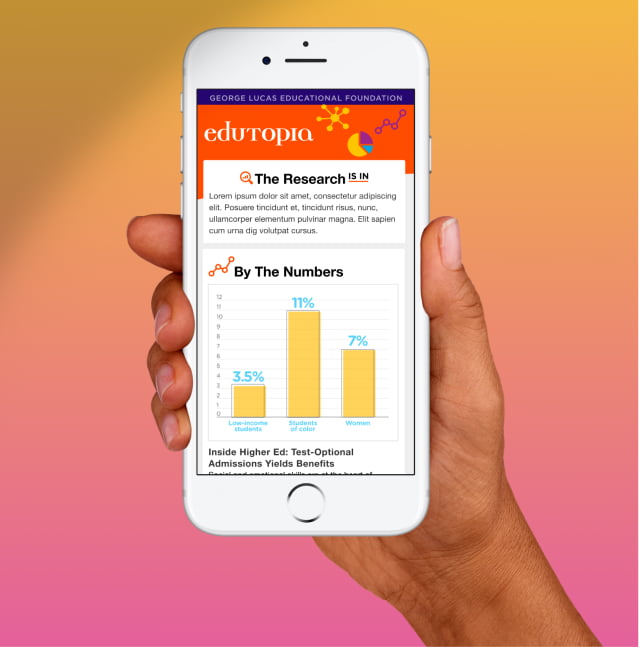
Have you had a fail lately? A professional development day that took an unexpected turn or a student activity that got more eye rolls than applause? As educators, we always aim for innovative, exciting, and relevant learning experiences for our students. But let’s face it: With innovation comes the occasional misfire.
In Right Kind of Wrong, Amy Edmondson writes, “Mastery in any field requires a willingness to learn something from the many mistakes you will necessarily make.” That’s the secret sauce: using failure as a launchpad. Here are three ways to take that epic fail and turn it into a springboard toward future growth and success.
MY EPIC FAIL
Here was one of my recent failures: When I was the principal of Ellis Middle School, we worked to implement a block schedule during Covid-19. Upon return to in-person learning, we wanted to keep some components of the block schedule as well as return to some components of the previous seven-period schedule. To refine our block schedule system, we introduced what we termed “the zipper.” The premise was to consolidate A and B days into an eight-period structure on Wednesdays, offering a unique approach to student scheduling. With bells meticulously synchronized, teachers well-prepared, and students equipped with their updated schedules, the moment arrived to put theory into action… and it was a total disaster.
Things rolled well until lunch, and that was when the chaos hit. Students’ lunch schedules did not align with the course schedule. Teachers took attendance in class and found that almost half their class was in the lunchroom, not the classroom. Around that time, students and teachers started to unravel, and the frustration started to leak out. We needed to step back, look things over, and figure out where we went wrong.
Start of newsletter promotion.

STEP ONE: REFLECT AND ANALYZE
Unfortunately, by the end of the first zipper day, our idea hit a snag. That meant it was time to reassess. Take the time to reflect on the failure and conduct a thorough analysis. Ask yourself and your team probing questions: What went wrong? Were there warning signs we missed? What factors contributed to the setback? Honest reflection is the first step toward extracting meaningful lessons from the experience.
At the end of the first zipper day, the counselors, the assistant principal, and a few key teachers met in the war room (aka the master scheduling board room) to review the courses and bell schedule. We practiced walking students’ schedules to see where the hiccup was. In the upcoming days, we asked students and teachers alike what they noticed and what suggestions they might have to prevent another zipper disaster when the next Wednesday came up on the calendar.
We learned which classes caused the conflict at lunch and how that impacted student schedules. We also had overlooked conflicts that teachers had if they taught one grade on A-days and another grade on B-days. We learned that even the best idea, with the best intentions, can have hiccups when enacted.
STEP TWO: SEEK FEEDBACK AND COLLABORATION
Don’t shoulder the burden alone. Engage with your team, peers, or mentors to gather diverse perspectives on the failure. Constructive feedback provides valuable insights and alternative viewpoints you might not have considered. Collaborative discussions can uncover root causes and reveal innovative solutions for future endeavors.
The following week, I remember sitting in my car preparing to enter the building, attend our staff meeting, and admit the failure. In my head, I thought I would walk into a room of boos and glares. Instead, I received welcoming smiles and a few laughs over the melee that had happened the week prior.
After a moment of vulnerability, we got to work, continuing to share ideas to fix what had happened. On our campus, we worked hard to become more curious about failure instead of taking it as a hit to our confidence. Instead of blaming others, we used that energy toward trying to figure out what had gone wrong and making it right.
STEP THREE: IMPLEMENT ADJUSTMENTS AND ITERATE
Use the lessons learned to strategically adjust your leadership approach or overall plan. Identify actionable steps to address the shortcomings and mitigate potential risks. Embrace a mindset of continuous improvement and iteration. Remember, failure is not the end but an opportunity to refine strategies, enhance decision-making, and fortify your leadership skills.
The “zipper” schedule was a teachable gold mine. By openly (and honestly) asking what had gone wrong, we figured out what we could change to make it right. And while we didn’t quite get that zipper schedule back, what we ended up with was much better. With feedback, we modified the block schedule to an A-B rotation and, with insight and input from our math department, ensured that there were an equal number of A and B days throughout the entire school year.
Remember, it’s not about the fall but about the rise. Take that failure, extract its wisdom, and let it propel you to even greater heights in your leadership journey. Incorporating these practices can transform failures into stepping stones for growth and resilience. So… when was the last time you had an epic fail, flop, or fall—and what did you learn from it?



